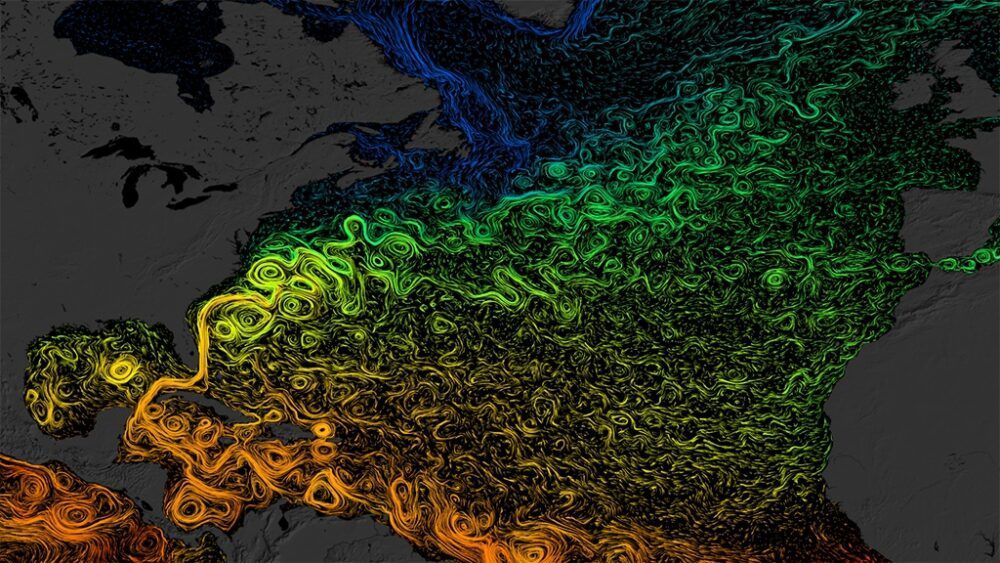
Will the collapse of the Atlantic current affect global maritime traffic?
Ocean currents determine the planet's climate and maintain the health of the seas and their ecosystems. But their balance is delicate. The melting of the poles caused by climate change is affecting, for example, the Atlantic Meridional Overturning Circulation System (AMOC). In fact, several scientific studies already speak of its future collapse, which would cause changes in the climate. Will the collapse of the Atlantic current affect global maritime traffic?

The currents that shape our climate
Ocean currents move large masses of water through the seas and oceans. They function as enormous conveyor belts that, by moving water, transport energy, matter and organisms and determine the climate of the entire planet. In the Atlantic, there is a system (unique to this ocean) that we know as the Atlantic meridional overturning circulation (AMOC).
The AMOC is formed by currents such as the Gulf Stream, which moves warm waters from the tropical areas of the Gulf of Mexico northward and cold waters from the northern areas toward the tropics. It is this current that determines, among many other things, that Europe's climate is considerably warm for the latitude at which it lies.
"If we could simplify as much as possible the very complex system of surface currents in the mid-water and deep waters of the Atlantic, we would have the following scheme: an upper current to the north (the warm branch of the AMOC, whose main contribution is the Gulf Stream) and another deep current to the south (the cold branch of the AMOC, which goes from 1,500 meters deep to the bottom)," explains Gabriel Rosón Porto, Professor of Physical Oceanography at the Faculty of Marine Sciences of the University of Vigo.
And what does the term "overturning" that gives this system its name refer to? As Rosón explains, the overturning occurs when the warm current reaches the North Atlantic (the Norwegian, Greenland and Labrador Seas). There it cools abruptly, so the water becomes denser, sinks and returns in the opposite direction and at a much greater depth. This cold branch is known as NADW ( North Atlantic Deep Water).
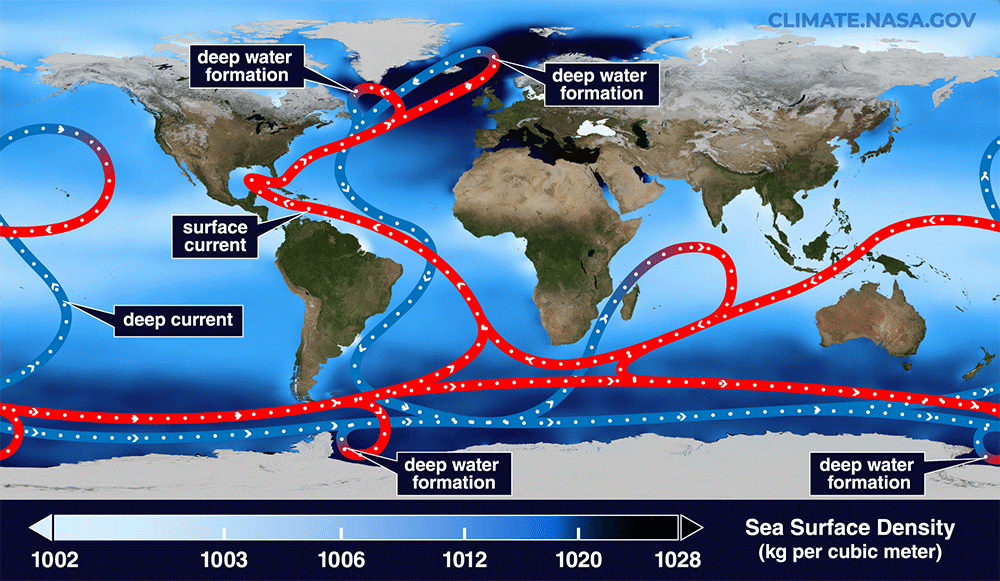
The global "conveyor belt" of ocean currents: red shows surface currents and blue shows deep currents. Deep water forms where the sea surface is denser. The background color shows the density of the sea surface (NASA/GoddardSpace Flight Center Scientific Visualization Studio).
Atlantic current system showing signs of slowing down
"The main consequence of this scheme for Europe's climate is that, in the process of sinking, the ocean releases a gigantic amount of heat into the atmosphere: a thousand trillion [million billion] watts that keep winters in northern Europe relatively mild, 5 to 10°C warmer than if the AMOC did not exist," says Rosón.
It is estimated that this system has been operating like this for several thousand years. However, the AMOC has changed in intensity in the past and may do so again. At least three recent studies warn that this Atlantic current system is showing signs of slowing down. Using global climate models, the reports determine that at some point the AMOC will reach a tipping point or point of no return.
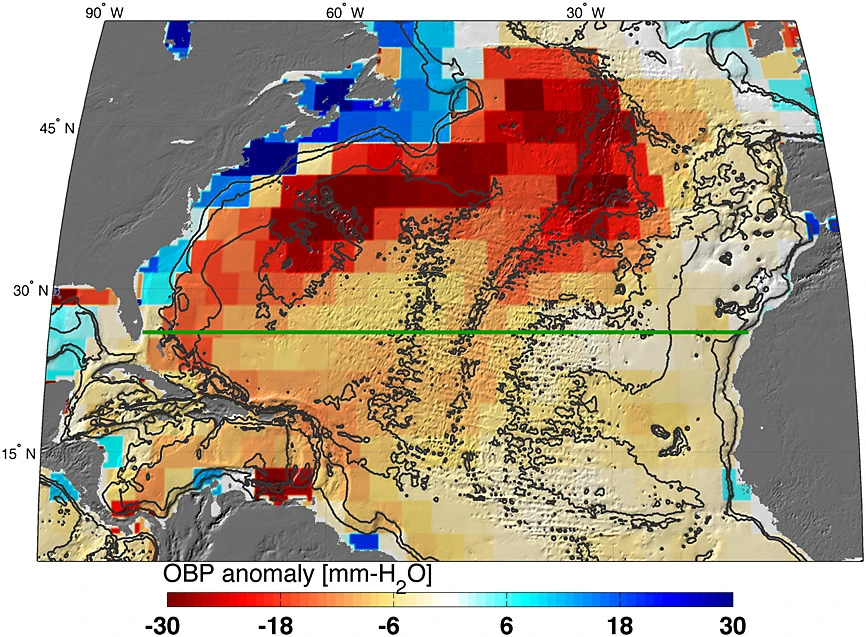
Causes and consequences of the weakening of the AMOC
“The Achilles heel of the AMOC is that, in the current context of climate change, Greenland's continental ice is melting," says the University of Vigo professor. "This constant addition of freshwater to the North Atlantic Ocean (right in the NADW sinking zone) creates a low-saline and stable surface layer that is counteracting and hindering densification, and therefore sinking and formation of the cold branch, so the AMOC is reducing its flow."
In other words, since fresh water from melt is less dense than salt water, it accumulates at the surface and does not sink, which slows down the circulation system. If the weakening continues, a tipping point or point of no return will inevitably be reached and the current system will collapse.
A University of Copenhagen study published in July 2023 indicates that the AMOC could come to a standstill between 2025 and 2095, although the most likely date is 2057. Using mathematical models and ocean temperature data from the last 150 years, the researchers determined that there is a 95% chance of this happening.
Another more recent study, published in February 2024 by researchers at Utrecht University, indicates that the circulation of the AMOC has slowed observably over the past two decades to what is probably the weakest state in nearly a millennium. The researchers estimate, based on climate models that simulate future conditions in which the amount of freshwater increases, that it may come to a complete halt within a century.
The consequences for the climate, say the Utrecht University researchers, "would be severe and cascading around the world." Weakened currents would mean that heat would not be released from the ocean to the atmosphere, so that average temperatures in North America and parts of Asia and Europe would be significantly reduced.
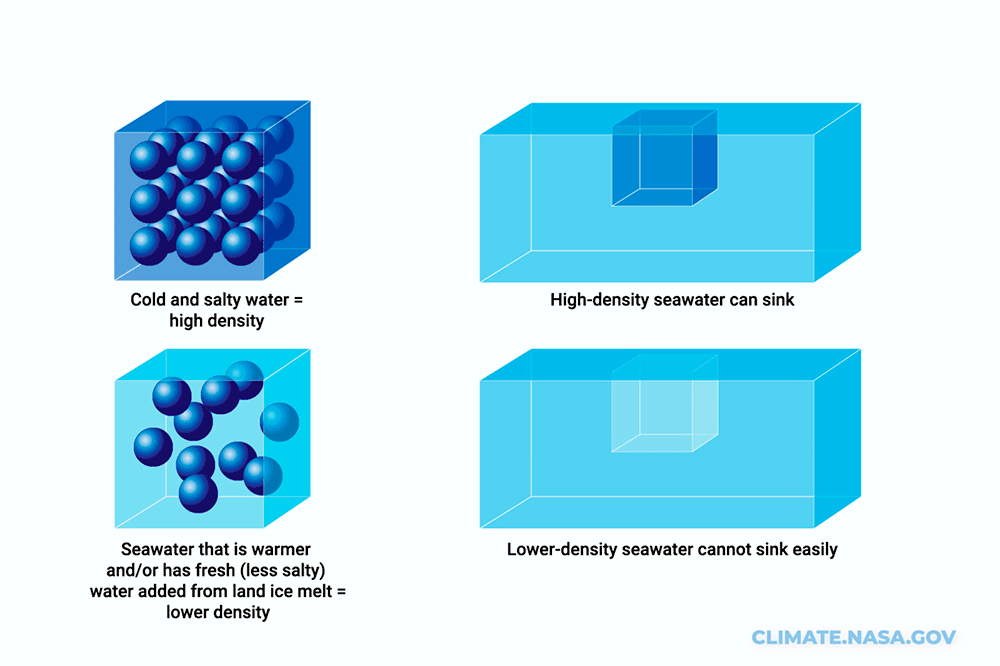
The density of seawater at the surface influences its ability to sink in the deep ocean: this illustration shows how density affects the ability of water to sink in the North Atlantic. The combination of cold and salt water makes it dense enough to sink. Changes in this density mean that less water will be dense enough to sink (NASA).
Consequences worse than we imagined
"Winters in Europe would be much more severe, between 5 and 10ºC colder," says Rosón. The results of the Utrecht University researchers, in fact, point out that some areas of Norway would experience temperature drops of more than 20ºC. On the other hand, southern hemisphere regions would warm, but only by a few degrees.
"Viewed globally, this is understood as a negative feedback of the Earth's climate system: as a positive thermal anomaly (climate change) is created, the system will respond by creating a negative thermal anomaly (the cooling created by the collapse of the AMOC)." The changes would also affect precipitation and cause effects on key climate ecosystems, such as those of the Amazon rainforest.
Javier Romo, head of marine environment at the Port of Barcelona, corroborates this view and goes even further: "The interruption of the currents generated in the northwest Atlantic will have worse consequences than we imagined: it will affect the global circulation of currents, reducing the buffering effect on the temperatures produced by the seas and oceans, and the dissolved oxygen at the bottom of the seas will decrease, with possible consequences such as anoxia in deep waters, alteration of the marine ecosystem and reduction of biological productivity".

Changes coming to the ports
"In our 21st century world, thanks to the high technology at play in shipbuilding, ocean currents affect shipping relatively little. However, there is a consensus in the scientific community that a slowdown and eventual blockage of the AMOC will bring us a colder North Atlantic and Arctic, with greater ice extent and more icebergs in more southerly latitudes, which would pose a threat to navigation," explains Rosón.
This would disrupt conventional shipping routes in the North Atlantic by forcing ships to adjust their routes to avoid ice. "It is likely that there will be ports blocked by ice or icebergs and ships will experience longer voyage times. This could increase operational and logistical costs for shipping lines, as well as shippers who rely on international shipping," explains Rosón.
"In addition, with the increased risks associated with sailing in potentially more dangerous or unpredictable waters, insurance premiums for vessels and cargoes are likely to increase. Insurers may consider routes affected by the AMOC slowdown to be riskier, resulting in higher costs for ship operators and traders," he adds.
All of this would force companies to reevaluate their logistics and warehousing strategies and could lead to significant economic changes in regions that rely heavily on international shipping.
"For example, if routes are affected, ports that have traditionally been key entry and exit points for trade could see a decline in activity. Additional challenges could be posed for maritime regulators and port authorities, which would have to adapt to changing conditions on the oceans. This would imply the need for new regulations or safety protocols to ensure the safe navigation of ships in more adverse weather conditions," explains Rosón.
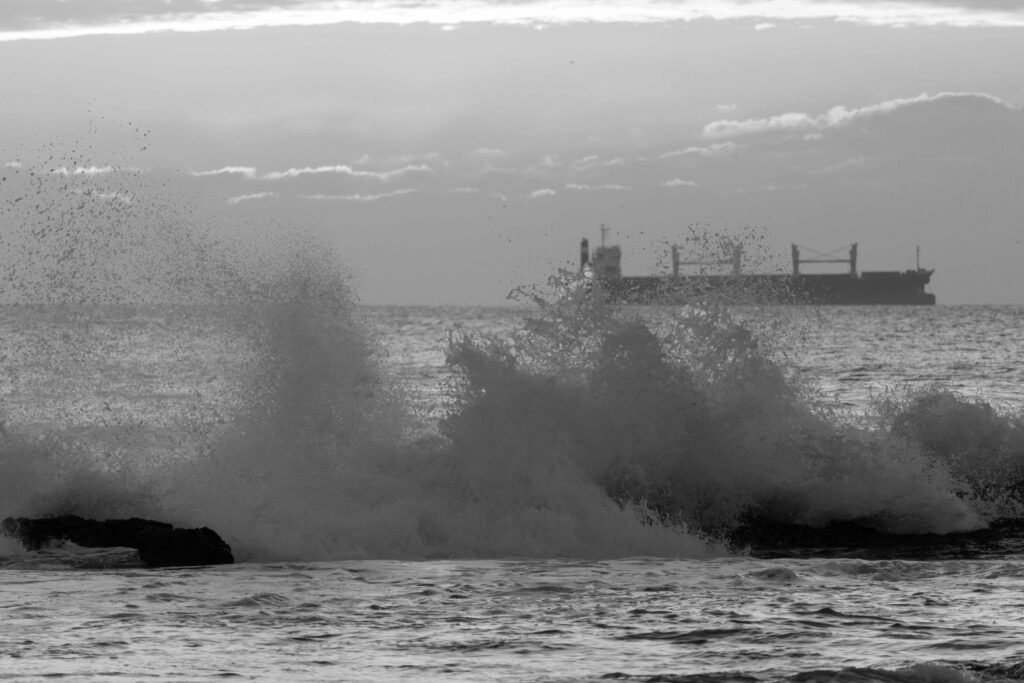
Uncertain scope to infrastructures and maritime traffic
The information we have about changes in the AMOC is based on mathematical calculations, and there is currently considerable uncertainty about how their consequences may affect port infrastructures.
As of today, this is not among the most prominent potential problems. "The hypothetical collapse of the AMOC would produce profound changes in the climate in Europe, which we cannot predict accurately given the complex interactions of the climate system. It is believed that there would be huge changes in temperatures and precipitation that would profoundly affect agriculture, probably making it impossible in northern Europe, and power generation. The least of these would be the infrastructure problem," explains Enrique Alvarez Fanjul, technical coordinator of Ocean Prediction, UNESCO's Decade of Oceans partnership center.
"In the worst-case scenario, that of a collapse, I don't think this problem is something to worry about. The problem would be that multiple socioeconomic sectors and their associated trade would be affected in ways that are difficult to foresee. Given the possible consequences of these phenomena, it is necessary to increase our knowledge of the climate system, which already adequately describes some phenomena such as the current sea level rise," adds Alvarez.
The only solution to avoid the collapse of the AMOC, says University of Vigo professor Gabriel Rosón, is to prevent the Arctic from melting. And the only way to do this is to reduce as much as possible the greenhouse gas emissions that cause climate change.
"We have just exceeded the famous temperature threshold of 1.5º C above the pre-industrial level and this only adds fuel to the fire," he says. "The probability of AMOC collapse increases depending on how long it takes us to finally reduce emissions. It is difficult to meet in the current energy context, but we must do what is possible (and impossible) to eliminate energy dependence on CO2."



